ARCHIVED - RPP 2007-2008
Library and Archives Canada
 This page has been archived.
This page has been archived.
Archived Content
Information identified as archived on the Web is for reference, research or recordkeeping purposes. It has not been altered or updated after the date of archiving. Web pages that are archived on the Web are not subject to the Government of Canada Web Standards. As per the Communications Policy of the Government of Canada, you can request alternate formats on the "Contact Us" page.
The Honourable Beverley J. Oda
Minister of Canadian Heritage and Status of Women
Message from the Librarian and Archivist of Canada
Management Representation Statement
Section I: Departmental Overview
Mandate of Library and Archives Canada
Section II: Analysis of Program Activities by Strategic Outcome
Section III: Supplementary Information
Legislation Administered by the Librarian and Archivist of Canada
Contacts for Further Information


The world in which Canadians live is constantly changing. Economic borders are blurring, new technologies are more accessible than ever before, and new approaches for showcasing our heritage and culture are increasingly available. These changes bring with them new challenges and increasing opportunities. Through their activities, organizations in the Canadian Heritage portfolio enable Canadians to take advantage of all the possibilities open to them with regards to culture, heritage, and civic participation.
Library and Archives Canada (LAC) plays an essential role as one of the key guardians of our collective memory. LAC puts Canadians in touch with their heritage and shares that heritage with the rest of the world.
In 2007-2008, Library and Archives Canada will be demonstrating its commitment to cooperation and diversity by hosting the third session of the International Council on Archives in Québec City. Flowing from the overall theme of Archives, Diversity and Globalization, the congress will focus on international cooperation, interdisciplinarity and professional identity, and globalization and diversity.
Library and Archives Canada's vision and objectives for the year 2007-08 are set out in this Report on Plans and Priorities. They highlight LAC's contribution to the vitality of Canada's cultural sector, and to building prosperous and creative communities throughout our country.
Beverley J. Oda
Message from the Librarian and Archivist of Canada
What is the value of the Library and Archives Canada (LAC) collection to Canadians and Canada?
The books, pamphlets and newspapers, the letters, diaries and official records, the films and broadcasts, the photographs, portraits and landscapes, the maps and the globes, which are just part of Canada's library and archives, maintain the voices, the images and the hopes of those who have gone before us. We add to them the documents of our generation, confident that the future will find these of significance for their time. The importance of Canada's documentary heritage is critical to the understanding of ourselves as a people, a society and a country.
The LAC collection offers a wide range of views and facts that permit a frank and open dialogue across the generations as we engage with past lives and explore the rich, diverse and complex Canadian experience first-hand through the eyes, voices and pens of those who lived it. We learn of successes and failures; we learn the strengths and weaknesses of our society, we discover the background to current issues and find insight into the continuing realities of Canada. We celebrate the past; sometimes we commemorate; at times we mourn and throughout we learn. As respected Canadian scholar Dr. T.H.B. Symons noted in his 1976 report on Canadian studies in universities, we come to know ourselves.
Only on this solid foundation can Canada's society plan its future. Only on this solid foundation can we truly seek to understand and address complex issues from our past.
In 2004, LAC articulated a comprehensive strategic vision to ensure that LAC makes the kind of contribution that truly enables Canadians to know ourselves. That vision, Directions for Change, has brought sharper focus to the work of Canada's newest knowledge institution.
At a time when government accountability is more important than ever, we have tackled the leadership issue of ensuring that the public record is accurately maintained and managed for future generations. Our collection is proving to be instrumental in addressing contemporary issues of past decisions that echo today: the head tax paid by Chinese-Canadians, the forced displacement of Japanese Canadians in the heat of war, First Nations' land claims and their residential school experience. The records of our borders, our constitutional development, environmental changes and the evolution of Canada's sovereignty eloquently demonstrate that in a modern society, the past remains current.
We are connecting with both traditional and new partners across Canada and around the world, building and enhancing networks that will ensure the greatest access to our collections and the broadest possible learning and research experience for our clients.
Now, Library and Archives Canada is at another critical turning point. We are making the strategic choices that are defining where we are going and how our institution will work to achieve its mandate. This Report on Plans and Priorities shows how we will address our ongoing responsibilities and move in new directions between 2007 and 2010.
It is important that we act for many reasons. For example, digital technology enables us to reach a national audience impossible just a few years ago. Our collections are rare, fragile, often unique and have substantial monetary value. Our growing web presence overcomes these limitations and allows people to enjoy and study our print manuscripts, large maps, films, stamp and Canadian music collection in homes, libraries and classrooms. Even so, we know we must do more to showcase the best of what our collection has to offer and make it accessible to all Canadians.
The downside of digital technology is that much of the recent digital record is already disappearing from our rearview mirror as governments, businesses, authors, scientists and photographers routinely push the "delete" button as they speed along the information highway. As this RPP demonstrates, we have made a major effort to establish our capacity to collect digital materials but we are struggling to allocate the resources and technology necessary to do as much of the job as is clearly needed. Investments in these and other areas are part of our plans to take on challenges such as improved security for our collection, increased preservation centre capacity to deal with a growing, fragile collection and the need to manage risks to our collection.
As we approach the 10th anniversary of our world-renowned Preservation Centre, one of the largest and most sophisticated in the world, it seems a fitting time to review our progress and gear up for the future. Our corporate priorities are aligned with the initial vision we set out in Directions for Change when Library and Archives Canada was created. This RPP illustrates how we are ready and determined to take the next steps and make significant progress to demonstrate those results. It demonstrates how we intend to enable Canadians to meet Dr. Symons' call to know ourselves and our past, while providing the solid foundation for our society to plan its future.
Ian E. Wilson
Management Representation Statement
I submit for tabling in Parliament, the 2007-2008 Report on Plans and Priorities (RPP) for
Library and Archives Canada
This document has been prepared based on the reporting principles contained in the Guide to the Preparation of 2007-2008 Part III of the Estimates: Report on Plans and Priorities.
- It adheres to the specific reporting requirements outlined in the Treasury Board Secretariat guidance;
- It is based on the department's Strategic Outcome(s) and Program Activity Architecture that were approved by the Treasury Board;
- It presents consistent, comprehensive, balanced and reliable information;
- It provides a basis of accountability for the results achieved with the resources and authorities entrusted to it; and
- It reports finances based on approved planned spending numbers from the Treasury Board Secretariat in the RPP.
Ian E. Wilson
Librarian and Archivist of Canada
Section I:
Departmental Overview
Mandate of Library and Archives Canada
The preamble of our enabling legislation, the Library and Archives of Canada Act, states that the mandate of Library and Archives Canada is:
- to preserve the documentary heritage of Canada for the benefit of present and future generations;
- to serve as a source of enduring knowledge accessible to all, contributing to the cultural, social and economic advancement of Canada as a free and democratic society;
- to facilitate in Canada cooperation among the communities involved in the acquisition, preservation and diffusion of knowledge; and
- to serve as the continuing memory of the Government of Canada and its institutions.
We achieve our mandate through a variety of responsibilities and activities and, increasingly, through work with the archives, libraries and museums across the country that also hold their own parts of Canada's national collection of cultural materials as well as other partners reflecting Canadian diversity.
LAC is constantly building our unparalleled collection of materials in a wide variety of formats of relevance to the story of Canada. Those formats include printed materials, photographs, electronic publications, maps and documentary art such as posters and paintings of people and places. Some acquisitions result from legislated Legal Deposit requirements that require publishers to provide copies of materials published in Canada. Others are acquired from Government of Canada departments and agencies and through the purchase or donation of materials.
We catalogue and describe these holdings in accordance with international standards to make it easier for people to find items. LAC's leadership role in cataloguing and describing materials for the Canadian archival and library communities makes access to the LAC and other collections across Canada simpler and consistent no matter where an item in a collection may be.
By managing the care of our collection, we ensure it is preserved for future generations. Our use of risk management approaches enables us to make the best use of LAC storage facilities as well as our staff expertise in applying preservation treatments and techniques.
The collection is enhanced by our role as the permanent repository of Government of Canada records of business or historic value for reference by the public. We ensure that records are available in response to public requests and to support departmental and government-wide decision-making. We also examine broad records issues of government and advise on improvements to help meet government priorities.
Our mandate within this framework centres on recordkeeping and accessibility. We are working towards establishing recordkeeping as a regulatory regime of accountability and stewardship within government in which records are created, used, kept and preserved as vital business assets and knowledge resources to support effective decision-making and achieve results for Canadians. A commitment to accessibility informs all LAC work on policies, strategies and methodologies to make government records more accessible to users.
Government recordkeeping is also the focus of work at LAC federal records centres in eight cities, where records in all media are managed on behalf of over 90 federal government departments and agencies. This extends from taking in records of continuing value from government institutions, including personnel records, storing and protecting them and retrieving those required for reference or research. As part of this, we segregate archival and historical records that are designated for permanent preservation, and destroy the others when no longer required. Centres also hold backup copies of electronic records that are deemed essential, in the event of disaster or emergency, to the operations of government and the protection of rights.
We seek to make our entire collection known in many ways to Canadians and people interested in Canada. For example, our client services help users understand how our collection and resources are organized and assist them to find items of interest and relevance. As necessary, we safeguard the rights attached to all holdings. This can involve providing rights clearances, investigating copyrights or ensuring privacy protection. It includes dealing with more than 20,000 requests annually that spur reviews of archival records, of personnel records of former civilian and military government employees, and LAC's operational records.
Library and Archives Canada reaches out to Canadians through exhibitions, learning opportunities, public programming and a rich website, including those within the Portrait Gallery Program initiative. In Canada's Capital Region, LAC stages this programming at our Ottawa and Gatineau locations and at partner venues. Canadians living elsewhere make contact with Canada's documentary heritage through our ever-expanding website, travelling exhibitions and special events, many involving collaboration with diverse partners.
LAC makes our collections available through resource-sharing services that include inter-agency borrowing/lending, document delivery and collaborative reference, as well as our work in partnership with the Canadian library community on the infrastructure that supports resource sharing. Within the federal government, this is matched by our coordination of the library services of federal departments and agencies to achieve excellence and to encourage the effective management of human and financial resources.
The financial and human resources of Library and Archives Canada are presented below.
Financial Resources
($ thousands)(Total Main Estimates)
|
2007-2008 |
2008-2009 |
2009-2010 |
|
$119,303.0 |
$100,987.0 |
$99,343.0 |
Human Resources
|
2007-2008 |
2008-2009 |
2009-2010 |
|
FTEs 1,134 |
FTEs 1,131 |
FTEs 1,116 |
Corporate Prioritie
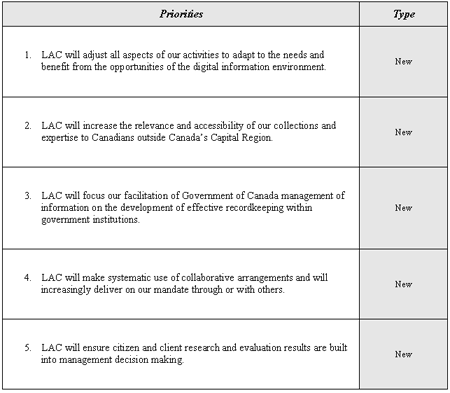
It should be noted that the achievement of all five corporate priorities involves actions for which particular sectors and groups within LAC have taken on lead responsibility. However, all sectors and groups are working together to ensure the achievement of all five priorities.
Crosswalk between LAC Program Activities and Corporate Priorities
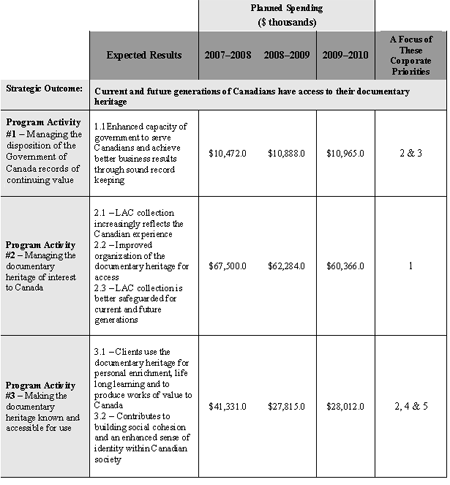
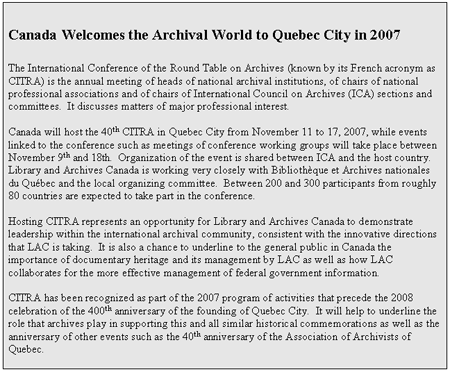
Departmental Plans and Priorities
Library and Archives Canada has a wide-ranging mandate, as described earlier in this section. To deliver on that mandate, in 2004 LAC established Directions for Change, a comprehensive, strategic vision that is shaping our management priorities and spending choices.1 To target that work even more effectively and to ensure that LAC delivers results that matter for Canadians and their federal government, we have taken a thorough look at the trends and factors influencing our mandate and the work of organizations like ours around the world.
Drivers for Change in our Planning Environment
1. A World of Digital Information
With extensive collections in many media such as sound recordings, films and documentary art, LAC has always faced the challenges of building and caring for a diverse collection that now has to include digital means of recording information. As the major home for the Canada's documentary heritage, LAC is now alert to collecting and archiving Canadian websites, electronic publications and other documents that will never appear on paper. We have already begun to implement the new infrastructure needed to guarantee the survival of this electronic information through initiatives such as the electronic legal deposit of publications, our AMICAN work that is creating a single system to manage our holdings and a search capacity from our website that enables Canadians to search our collection.
2. Canadians' Changing Interests and Realities
One obvious impact of this new digital world is the way the Internet has transformed how Canadians find, use and share information. More and more Canadians, not just professional researchers, want access to our collection, particularly with the growth of interest in topics such as family histories. Canadians want online access to the information in their national collection. At the same time, we are working to ensure that our collection reflects an increasingly diverse society, both in terms of what our collection holds and how we reach out to many different groups of Canadians. We are acting on these opportunities through initiatives such as our upcoming Genealogy Strategy, public programming focused on specific communities and improved services for Canadians to search our collection online.
3. A Networked World
One more impact of the growth of digital technologies is how it enables networks to be built and operated. This creates great opportunities for LAC because Canada's documentary heritage exists in cultural institutions across Canada and in other countries - not just in our own facilities. New tools and new thinking are creating opportunities to enable LAC to work in partnership with others to achieve shared goals, putting Canadians in touch with their heritage, no matter where they are or the heritage items are located. This attention to building and using networks also reflects the government-wide commitment to engaging stakeholders, citizens and other levels of government in the development of policy, programs and service delivery. We are acting on these opportunities through initiatives such as our work with stakeholders to create a common Canadian Digital Information Strategy as well as much of our public programs and services.
4. Becoming a Window on Canadian Democracy
Library and Archives Canada has specific responsibilities related to Government of Canada documents of business and historical value. Canadians are increasingly interested in these documents as shown by a rising volume of Access to Information requests and increased interest in exploring government documents linked to past decisions. At the same time, federal departments and agencies are recognizing that their recordkeeping practices need to improve to meet current public and parliamentary expectations.
5. Accountability for Resources and Results
Canadian public administration has undergone a significant shift over the past decade to emphasize clear results and accountability for spending. The Government of Canada is reassessing programs to focus on core federal roles and to ensure that spending is controlled and efficient. LAC, like all departments and agencies, has to reassess the effectiveness of our business processes, develop mechanisms to reallocate resources from low to high priorities and ensure that spending is directed to measurable and realistic outcomes. This is particularly important as we address the many challenges of caring for our collection and ensuring its security. It is influencing profoundly our capital investment choices.
The Strategic Framework
In 2006, LAC adopted a new Strategic Framework that has put us squarely on the path to the future we intend to create for ourselves. It sets out how we will rebalance our activities in light of our changing environments. It defines the five LAC corporate priorities, listed above in this section, that we will make in order to implement Directions for Change and identifies how we will change the way we do business.
While the five corporate priorities vary in nature and complexity, each requires a significant rebalancing of the way we carry out our business. LAC will rethink many activities in relation to more than one of the priorities as we strive to be:
- much better-known among Canadians as we reach out actively to people and communities of all kinds, reflecting their interests and the importance of telling Canada's many stories;
- even more strategic in our operations as we draw on networks and make capital investments that generate the best possible contributions to the achievement of our mandate, ones that allow us to serve as the trusted repository for Canada's documentary heritage and a valued cultural leader and internationally-recognized innovator; and
- a key supporter of the strongest possible accountability in government and a more vibrant Canadian democracy as we align our government records roles with the needs of citizens, parliamentarians and government managers and leaders.
We are on a path to become much more than the sum of our institutional parts through the five corporate priorities, three of which that focus on what we will do and two that focus on how we will move ahead.
What we will do:
Corporate Priority #1 - LAC will adjust all aspects of its activities to adapt to the needs and benefit from the opportunities of the digital information environment.
We will extend our efforts and increase our investments in acquiring and preserving Canada's digital documentary heritage, and in making use of digital technologies - both to improve access and awareness and to rethink our business processes and operations.
This objective will require the development of a comprehensive digital asset framework that will support fully automated ingest, preservation and access to digital documentary heritage. We will increase our rate of digital acquisition to deal effectively with the annual production of documentary heritage; we will develop functional specifications for digital recordkeeping in government. LAC will also begin working with partners to build a national network of Trusted Digital Repositories that will provide reliable and long-term access to items that exist in digital formats.
LAC will work towards integrated access to our collection by means of an enhanced website that is even easier to use, and is more dynamic and interactive. LAC will digitize for use and for preservation and will steadily build the volume of documentary heritage available on our website. LAC will systematically rethink the services we deliver, both to content creators and to content users, and the way in which we do business in order to respond to the demands and maximize opportunities of the digital environment.
Rebalance:
While LAC has already made significant steps towards the stewardship of digital information and the use of digital
technologies in its business, this choice will require us to rebalance our capacity to deal with digital and digitized
collections and favour ongoing investment in communication and access via our website. It will also favour
reengineering of business processes to take advantage of digital solutions.
High Level Results:
- Digital documentary heritage is acquired and preserved for future generations;
- In their homes, offices or anywhere with hand held devices, Canadians have more extensive and effective access to their documentary heritage;
- LAC makes efficient and effective use of IT in all of its business activities.
Corporate Priority #2 - LAC will increase the relevance and accessibility of LAC collections and expertise to Canadians outside Canada's Capital Region.
In order to make the documentary heritage of Canada known, LAC will focus on activities that demonstrate the relevance and increase the accessibility of our collections to Canadians who live outside Canada's Capital Region. This shift in service horizon will build on a market segmentation of current and potential clienteles to identify particular needs and interests. LAC will deliver products and services in formats appropriate to the clientele and will increase the relevance and accessibility of our collections by increasing digital access and content and by working both with organizations who share custody of the documentary heritage and with targeted communities such as genealogists, multicultural communities, teachers, librarians and archivists. LAC will make use of the expertise of our staff both to improve access and to develop content relevant to Canadians in all regions.
Rebalance:
LAC will actively work to make our collections and expertise accessible outside of the Ottawa-Gatineau region; this
will involve examining the kinds of programming that best meet the needs of Canadians and how they can be delivered.
LAC will review the role of our Regional Information Management Services in making the collection accessible.
High Level Result:
Canadians outside Canada's Capital Region have improved access to LAC programs and services relevant to their needs
and interests.
Corporate Priority #3 - LAC will focus its role in Government of Canada information management on the development of effective recordkeeping.
The capacity of federal departments and agencies to operate effectively is affected by their challenges in all areas of managing records of business value. LAC will therefore focus our government information management role on the development of a Recordkeeping Regulatory Regime that will facilitate accountability and stewardship in the creation, use, management and preservation of records as vital business assets and knowledge resources to support effective decision making, policy development, and the delivery of programs and services to Canadians. We will also assist the Government of Canada in ensuring the accessibility of its records of on-going business value.
Rebalance:
LAC will move from a general focus on information management in government to concentrate more attention on the need by
departments to identify records of business value. We will also revisit our storage model for federal records.
High Level Result:
Government of Canada institutions demonstrate the capacity to create, use and preserve records of long-term value as
reliable evidence of business decisions, activities and transactions. How we will move ahead:
Corporate Priority #4 - LAC will make systematic use of collaborative arrangements and will increasingly deliver on its mandate through or with others.
LAC can benefit from working with others, as we have in the past, but in order to achieve our mandate, we need to expand this approach. More significantly LAC can benefit from the synergy and more effective results of working with or through others. The model for this new way of doing business is evident on the web. Distributed networks permit a variety of institutions to make contributions based on their strength and capacity. By working together, institutions can realize economies of scale, improve service levels and maximize investments in information and communications technologies and in professional expertise.
In order to achieve this corporate priority, LAC will have to realize a major institutional change. We will shift attitudes from a focus on "doing" to a focus on collaborating or enabling. We will need to develop the necessary capacity and infrastructure to negotiate and manage a wide range of partnerships. LAC will actively seek opportunities to deliver on our mandate by working with or through others.
Rebalance:
LAC will move from being opportunistic to being more strategic, long-term and sustainable in our partnership practices.
We will systematically and comprehensively use collaborative arrangements as a means of delivering on our mandate.
High Level Result:
The LAC program is more efficiently and effectively delivered through extensive use of partnerships with
others.
Corporate Priority #5 - LAC will ensure citizen/client research and evaluation results are built into management decision making.
As LAC moves beyond providing well established services to a traditional clientele, the institution requires an enhanced user research and evaluation capacity. The quantitative and qualitative evidence provided by such research will be a key contributor to more effective decision making. User research and evaluation will be critical in enabling LAC to identify Canadians' changing needs and to serve new markets, as well as to meet our accountability requirements as a federal department.
Rebalance:
LAC managers will use formal and informal evaluation processes to determine federal department needs and user
satisfaction when making decisions.
High Level Results:
- Canadians' need for and interest in documentary heritage is understood and acted on in the planning and delivery of the LAC mandate;
- An integrated LAC approach provides federal departments the seamless access to products and service they require.
From Strategic Framework to Results
Library and Archives Canada has a broad, national mandate that our institution must work strategically to fulfill. We must adopt strategies that enable us to extend the reach of our activities and increase our effectiveness. With the corporate priorities set out in the Strategic Framework, LAC has begun to define how we will accomplish that mandate:
- We will move from an institution that is primarily analog to one that is primarily digital.
- We will move from largely being an independent player to being principally a partner who works with or through others.
- LAC will shift from being an institution whose function is primarily operational to become an institution whose role is a blend of operations, policy and enabling others.
We have identified two critical success factors in accomplishing this strategic alignment of our institution. The first is a sea change in our management and operational practice. In parallel with our commitment to collaborative arrangements with other institutions, LAC will also transform its business practices to establish internal collaboration as the defining characteristic of our institutional culture. We will favour interdisciplinary or inter-sectoral approaches and teams able to move strategic projects forward; we will look for leadership from our executive and managers in modeling collaboration to achieve corporate goals. The second success factor requires the systematic review and reengineering of our business practices, and reallocation of resources to support implementation of the Strategic Framework.
LAC is now embarked on the building of a new business model built on Directions for Change and the Strategic Framework. We will change the way we work, difficult as that might be at times, and align our resources so that we generate the key results that we wish to achieve for Canadians.
Links to the Government of Canada Outcomes
Through its strategic outcome and as a result of its activities, LAC supports Canada's Performance objective - A Vibrant Canadian Culture and Heritage.
Section II:
Analysis of Program Activities by Strategic Outcomes
Effective with the 2006-2007 fiscal year, Library and Archives Canada began to focus planning and reporting to Parliament and the central agencies of the Government of Canada through the achievement of a single strategic outcome:

Within that strategic outcome we identified three program activities that encompass the range of activities under the mandate that Parliament set out through the Library and Archives of Canada Act. Each is described on the following pages.
Program Activity #1: Managing the disposition of the Government of Canada records of continuing value
Financial Resources
($ thousands)(Total Main Estimates)
|
2006-2007 |
2007-2008 |
2008-2009 |
|
$10,472.0 |
$10,888.0 |
$10,965.0 |
Description of Program Activity: Through the issuance of Records Disposition Authorities, the development of record-keeping advice, tools and guidance, and the provision of Federal Records Centre and Council of Federal Library services for departments of the Government of Canada, LAC enables and facilitates the management of information within federal agencies and ensures that government's archival and historical records are identified and appropriately preserved.
This program activity includes many ongoing activities but under our new Strategic Framework we are seeking to accelerate our transformation through actions under the following two corporate priorities.
Corporate Priority #2 LAC will increase the relevance and accessibility of LAC collections and expertise to Canadians outside Canada's Capital Region
We have identified one key commitment under this corporate priority that will be relevant to this program activity in 2007-2008.
Key Commitment 1 - Optimize the role of government record centres to support preservation and access
LAC has a network of eight Regional Information Management Services, located in eight cities across Canada. To make progress on this key commitment, we will develop and implement an Accessibility Strategy that will make a particular emphasis of improving accessibility to federal government records that are held outside of Canada's Capital Region. The Accessibility Strategy will focus on streamlining the manner in which departments and agencies transfer records to Library and Archives Canada and how LAC preserves those records for use by federal institutions and Canadians.
Corporate Priority #3 LAC will focus its role in Government of Canada information management on the development of effective recordkeeping
We have identified three key commitments under this corporate priority that will be relevant to this program activity in 2007-2008.
Key Commitment 1 - Lead the development of an action plan arising from the ADM Roundtables and participate in its implementation
Improvements in government recordkeeping are recognized as a priority in enhancing accountability throughout the Government of Canada. In 2006, we initiated a process with the Privy Council Office to hold Deputy Minister (DM) Roundtable sessions on government recordkeeping and information management. The goal of this process was to seek DM-level engagement on recordkeeping issues and improve departmental stewardship of records through recognition of five key principles:
a) proper recordkeeping is an essential enabler for the multitude of Government of Canada programs and services, and
for meeting regulatory and performance requirements;
b) proper recordkeeping facilitates sound business management;
c) records are a key business asset and must be effectively managed;
d) understanding recordkeeping is an invaluable part of creating a culture of accountability and transparency;
and
e) all Government of Canada employees benefit when they engage in proper recordkeeping during the course of their daily
business activities.
The DM Roundtable sessions resulted in collective recognition by the senior executives that the management of government records and information needs to be modernized, just as the key management regimes relating to finance and human resources were modernized through the initiatives of modern comptrollership, the Management Accountability Framework (MAF) and the Public Service Modernization Act.
It was recognized that solutions for improving recordkeeping would require collaboration across the government. Accordingly, the DM Roundtable consultations resulted in the creation of an ADM-level taskforce.
During 2007-2008 the task force is expected to identify how to create a sustainable culture of, and a regulatory regime for, recordkeeping in government, and strategies to support implementation. Specific immediate outputs will be a directive on recordkeeping in government, a regulatory regime for recordkeeping and the development of proposed solutions for specific recordkeeping issues (e.g., risk, capacity, legacy and electronic records), with an overall action plan. Implementation of approved actions would then take place on a multi-year basis. Key Commitment 2 - Develop a methodology to enable departments to identify records of business value
Government departments and agencies produce immense numbers of records each year. The long-term challenge is to determine which of those records are of business value, and therefore require ongoing management to preserve them for later use when needed by government institutions and Canadians.
In 2007-2008, LAC will make progress on an Accessibility Agenda, driven by a collaborative approach building on partnerships within LAC and across the Government of Canada and drawing on the implementation of recommendations that were made in 2006-2007. The Agenda will touch on all aspects of the record continuum, involving enhanced advisory services to federal departments and agencies on recordkeeping, streamlined transfer and disposition procedures as well as the development of a strategy for legacy records and the acquisition, preservation and accessibility of electronic records.
In particular, we intend to develop a methodology to enable departments to identify records of business value. We also will develop and consult, both within the Government of Canada and beyond it, on draft functional specifications for digital record keeping.
When implemented over time, the Accessibility Agenda will lead to improved mechanisms for acquiring and describing archival records in all media to make them more accessible to Canadians. We expect to measure success by more efficient workflows, improved intellectual control and enhanced services to clients in the Government of Canada and the Canadian public.
Key Commitment 3 - Begin the implementation of a new storage model for legacy records of the Government of Canada
The 2007-08 fiscal year will mark the beginning of significant changes for our Regional Information Management Services. LAC is developing a new storage model that will allow the institutions and Government of Canada departments and agencies to manage the enormous backlog of textual and electronic records. This work will result in an LAC action plan to address paper and electronic storage capacity in the Government of Canada for implementation in the following years.
Program Activity #2: Managing the documentary heritage of interest to Canada
Financial Resources
($ thousands)(Total Main Estimates)
|
2006-2007 |
2007-2008 |
2008-2009 |
|
$67,500.0 |
$62,284.0 |
$60,366.0 |
Description of Program Activity: The building of national documentary resource for all aspects of the study of Canada is fundamental to the mandate of the Library and Archives of Canada. The Library and Archives collection consists of published and unpublished materials in a variety of formats acquired through Legal Deposit, Agreements with government institutions and selected private materials purchased or received by donation. To access the contents of collections, they must be described. Description can take many forms and provide various layers of access but is governed by nationally and internationally accepted codes of practice. At the same time, holdings are also described to meet Canadians' expectations for timely and equitable access. Once materials enter the LAC collection they are managed to ensure their long-term preservation and accessibility through policies, procedures and various programs including storage, conservation, and restoration and copying. To fulfill its role as a permanent repository of the government records and publications, the Library and Archives enters into agreements with government institutions to ensure that documents of historical and archival value are eventually transferred to LAC. LAC also provides advice to assist government institutions in fulfilling their obligations under Sections 12 and 13 of the Library and Archives of Canada Act.
This program activity includes many ongoing activities but under our new Strategic Framework we are seeking to accelerate our transformation through actions under the following corporate priority.
Corporate Priority 1 LAC will adjust all aspects of its activities to adapt to the needs and benefit from the opportunities of the digital information environment
We have identified four key commitments under this corporate priority that will be relevant to this program activity in 2007-2008.
Key Commitment 1 - Define a Canadian Digital Information Strategy
We are continuing to move forward on our ongoing determination to implement a national strategy for digital information production, preservation and access. Based on our leadership role in this area and the results of a national summit held in December 2006, including representatives of libraries, archives, museums, data centres, publishers, producers, distributors, rights organizations and academia, we intend to lead the development of a collaborative, decentralized Canadian digital information strategy during 2007-2008. In following years, we expect this strategy to open the way for more coordinated activity to build Canada's capacity to produce high quality digital information resources, to digitize key parts of its non-digital information riches and to preserve for future use information produced in digital form.
Key Commitment 2 - Begin development of Trusted Digital Repository services and network
The development of a suite of Trusted Digital Repository (TDR) services is central to LAC's capacity to meet our legislative obligations to acquire and preserve more of the rapidly growing volume of Canadian digital documentary heritage. A TDR provides and manages reliable, long-term access to digital resources. It is organized to address typical challenges such as the volatile nature of digital objects and the change in the information technologies used to create and access them.
LAC, like similar organizations around the world, sees development of TDR services as vital to addressing the tremendous scope and breadth of Canada's growing digital documentary heritage. Our leadership in this area will contribute to the development of TDRs by other libraries, archives, museums and public institutions.
Our TDR work began in 2006 and should continue until 2009. We are focusing on building a solid policy and technical infrastructure for effective management of submission information from content creators. We are addressing the management of metadata related to the technical, descriptive and rights attributes of the content. We intend to ensure that people will be able to find digital resources, thanks to consistent naming, storage and locating practices as well as preservation tactics that will enable long term access to obsolete file formats. Much of this work will involve partnerships with content creators and other institutions and initiatives that share common digital missions and issues.
Key Commitment 3 - Develop the "Virtual Loading Dock"
The Library and Archives of Canada Act now requires that publishers deposit their electronic publications with LAC. A "Virtual Loading Dock" will provide an automated vehicle through which publishers can comply with that requirement more efficiently for themselves and LAC, regardless of medium or file format and using numerous transfer mechanisms. Linked to the Trusted Digital Repository (TDR) being developed that was mentioned above, we expect to achieve automated management of submission information as well as other features such as harvesting of digital information, the use of webforms and effective file transfer approaches.
Over time, we expect this electronic infrastructure will enable us to acquire other content through contracts with private donors and record disposition authorities for government records. We will gauge the success of this initiative by tracking the increase in acquisition of digital content and the increase of depositors and donors who work with us.
Key Commitment 4 - Set up several projects to enable users to add information to our catalogues
Historically, LAC has received information from individuals and organizations such as publishers that we have then input into our catalogues. With new digital tools, it is now possible for LAC to make the process more efficient by establishing a capacity for others to input information directly into our catalogues - much as has already proven valuable when Canadian universities provide us with metadata related to doctoral theses and dissertations. A key need that has to be met in these processes is that the information has to meet the standards that users of our catalogues require for a consistent ability to search and make use of information, regardless of who placed it there.
During 2007-2008, and in conjunction with the implementation of the Trusted Digital Repository services that we described elsewhere in this section, we expect to launch projects that will test ways of creating opportunities for users to add information to our catalogues, while maintaining the standardization needed by LAC partners. We are considering projects such as:
- mechanisms for publishers to submit bibliographic data in a designated format for use by LAC;
- mechanisms that would make it possible to extract metadata automatically for digital publications, thus speeding the work of LAC staff;
- using two of our virtual exhibitions to solicit descriptions from users of unidentified photographs; and
- introducing a capacity for users to add information related to genealogy as part of our larger Genealogy Strategy.
Regardless of which projects are implemented, we will assess their outcomes through measures such as the number of users adding data and the number of records that have data provided by users.
Program Activity #3: Making the documentary heritage known and accessible for use
Financial Resources
($ thousands)(Total Main Estimates)
|
2006-2007 |
2007-2008 |
2008-2009 |
|
$41,331.0 |
$27,815.0 |
$28,012.0 |
Description of Program Activity: All materials that become part of the LAC collection are intended for use by those interested in Canada. LAC provides information and services including consultation, research and lending, across multiple channels to facilitate access to the documentary heritage to a wide variety of clients. It also establishes programs, such as the Portrait Gallery Program, and encourages or organizes programs such as exhibitions, publications and performances, to make known and interpret the documentary heritage. LAC also provides information resources and standards such as the national catalogue and supports the infrastructure necessary to ensure its accessibility to those interested in Canada.
This program activity includes many ongoing activities but under our new Strategic Framework we are seeking to accelerate our transformation through actions under the following four corporate priorities.
Corporate Priority 1 LAC will adjust all aspects of its activities to adapt to the needs and benefit from the opportunities of the digital information environment
We have identified one key commitment under this corporate priority that will be relevant to this program activity in 2007-2008.
Key Commitment 1 - Integrate virtual and in-person planning and delivery of making known activities
"Making known activities" include all our outreach and public programming opportunities, whether virtual or in-person, that are of interest to LAC audiences and partner communities. LAC resources provide much of the funding for this programming, complemented by support from the Department of Canadian Heritage's Canadian Culture Online Program (CCOP). Given the commitment to increased integration of digital approaches into our strategies, including for public programming, we will now plan for the development of programming that has both virtual and in-person elements. As this becomes established, LAC will have the potential to reach Canadians more effectively wherever they live and in the format that is best suited to their needs and interests.
Corporate Priority #2 LAC will increase the relevance and accessibility of LAC collections and expertise to Canadians outside Canada's Capital Region
We have identified two key commitments under this corporate priority that will be relevant to this program activity in 2007-2008.
Key Commitment 1 - Work with networks to enhance delivery of the Strategy for Public Programming and the Genealogy Strategy, and the Portrait Gallery Program's Travelling Exhibition
The resources and expertise in supporting Canadians to make use of the LAC collection represent some of our most direct services to individual Canadians. However, our Strategic Framework recognizes that we can do much more to reach out to Canadians. During 2007-2008, we intend to move forward with initiatives that will build our collaboration with partners to connect better with Canadians through our Strategy for Public Programming and our Genealogy Strategy.
Our Strategy for Public Programming was approved in early 2006. It is implementing the LAC commitment to take an approach to public programming that actively increases awareness of, access to, use and understanding of Canada's documentary heritage through the achievement of five objectives:
- Increase interest and awareness in Canada's documentary heritage
- Increase understanding of the Canadian experience
- Generate life-long learning opportunities
- Make a personal, emotional connection with Canadians
- Create visibility for LAC
Consistent with the approach set out in the Strategic Framework, the Strategy for Public Programming sets a path with much greater use of partnerships than has traditionally been the case, a strong focus on identifying the needs and interests of Canadians to guide programming choices, the expanded use of the internet and technologies to make the collection accessible to people regardless of their location and a clarity of focus for programming.
During 2007-2008, we intend to continue to implement the Strategy through a wide range of initiatives. For example, we want to expand the use of LAC resources by educators. One way we will do this is through consultation with faculties of education at Canadian universities to determine the needs of new teachers that LAC may be able to assist in meeting. Consistent with our commitment to becoming a more digital institution, we will increase access to LAC learning resources via digital suppliers. We also will review and update selected current educational resources.
Under the Strategy, we expect to move forward on other activities, which will mean changes to some established approaches. One example is the projects that we have under the Canadian Culture Online Program, noted above. We intend to ensure that educational components are included in all those projects as well as selected exhibitions/public programming initiatives to increase our value to the educational community.
Our active approach to implementing public programming, in conjunction with other commitments to reflect the needs and interests of Canadians of all kinds will ensure that we build and use a better knowledge of our target audiences. It will communicate to Canadians the strengths and scope of our collection, as we highlight selected media within the collection. More generally, it will support our partners and encourages literacy and an appreciation of Canada's heritage.
Although distinct from the Strategy for Public Programming, our Genealogy Strategy is based on the same commitment to meet the needs and interests of Canadians. This Strategy is being developed to address the growing interest in family histories among Canadians. We are a partner with, among others, the provincial and territorial archives who hold most of the genealogical records in Canada and we expect to be able to make unique contributions as the Strategy unfolds during 2007-2008. For example, we will work to connect the Canadian Genealogy Centre website, which we are developing, to a new Canadian Genealogy Portal that the community of genealogical partners across Canada is planning to develop. Our website will be a core part of a national collection through links to other repositories in Canada. We also expect to work with our partners to provide links to their resources and knowledge for people researching family histories and local community histories.
Our goals for the Genealogy Strategy are to make LAC a significant partner in the search for an individual's family history and ensure that we remain relevant to the genealogy community. We will measure the increase in new partnerships and additional resource links provided via our genealogy website. In addition, we expect to measure our performance through elements such as user research and client satisfaction indicators. More generally, progress on our Genealogy Strategy should help us to build stronger links to more partners as we all work to ensure the development of a strong Canadian genealogy sector.
The Portrait Gallery Program will increase its visibility through selected travelling exhibitions, eg. Niro/Thomas First Nations Portraiture, allowing for wider accessibility of portraits to Canadians and a better understanding of the story of individuals who built Canada.
During 2007-2008, we also intend to expand our strong partnership with TD Bank Financial Group and libraries across Canada to promote reading through the TD Summer Reading Club.
Key Commitment 2 - Develop and implement an institutional plan to follow up on multicultural consultations
Library and Archives Canada is determined to ensure that our collection reflects Canada's multicultural heritage and that Canadians of all cultural backgrounds find material of relevance and interest to them in the collection and through our programs and services. We have conducted a consultation process within LAC and with some multicultural communities. During 2007-2008, we will continue these discussions, which will lead to our development of an institutional framework for increasing the multicultural relevance of LAC's collection. This will enable our collection to reflect the diversity of Canadian society and will better serve multicultural communities and all Canadians.
Corporate Priority #4 LAC will make systematic use of collaborative arrangements and will increasingly deliver on its mandate through or with others
We have identified three key commitments under this corporate priority that will be relevant to this program activity in 2007-2008.
Key Commitment 1 - Develop a partnership policy and framework
A fundamental step in developing successful partnerships that will enable LAC to better deliver our mandate is to put the key guidance and tools in place. During 2007-2008, we intend to develop a partnership policy and framework to guide our actions. As part of this, we will prepare model agreements, procedures, guidelines and other tools necessary for consistent, effective and appropriate action. This effort will take place with the engagement of groups throughout LAC and with appropriate sectors of the community.
We expect these actions to create the necessary infrastructure to negotiate and manage successful partnerships, which will be demonstrated over time as LAC negotiates and manages an extensive range of successful partnerships that foster more effective and efficient delivery of LAC programs.
Key Commitment 2 - Initiate pilot projects to work in partnership on acquisition, preservation, access and/or making known projects, including creators, memory institutions or user groups as appropriate
As noted above, "making known projects" are about making our holdings and resources, as well as Canadian stories, known to Canadians through outreach and public programming. However, we potentially have many partners who share our goals and whose collections or access to audiences would be beneficial in helping LAC to reach our goals. In 2007-2008, we will identify some of those partnership possibilities and investigate possible partners that will contribute to and further LAC's overall strategic objectives while increasing access to and visibility of the collection.
We expect these partnerships will allow users to gain access to more material from our collection and those of partners, including access to a more diverse selection. By providing that expanded access more quickly and efficiently, all partners will better serve the needs and interests of users and LAC, in particular, will enhance our connections with more Canadians.
Another aspect of this key commitment will be to announce a new partnership approach, which will include inviting proposals from traditional and non-traditional partners, leading to the launch of early pilots.
For example, we intend to explore the direct lending of our library material to the public through a pilot project under the SmartLibrary initiative in the Ottawa area. SmartLibrary is a partnership of public, university, government and institutional libraries that offer integrated information resources to users. Through it, LAC will determine how best to offer individuals direct access to the rich resources of our collection and how to measure the impacts of this initiative.
The Portrait Gallery Program activities are currently and will continue to be partnered in exhibitions, outreach (eg. Community Portraits) and through acquisitions fund-raising. This is expected to increase involvement and interest by diverse Canadians, as well as increase visibility to the LAC's holdings. The preservation and care of the LAC portrait collection will remain a priority, as options for a permanent site for the Portrait Gallery of Canada are explored
We also will explore the feasibility of off-site lending of non-circulating materials from our collection through the existing network of interlibrary and inter-institutional partners. Should we decide to launch a possible pilot project, Canadians may be able to borrow specific materials that have been in our non-circulating collection until now and do so through the convenience of their local information resources, such as a local library. If successful, this approach would increase access of LAC's collections to citizens regardless of their geographic location. It would also provide more user-centred services.
Key Commitment 3 - Continue implementation of the National Archival Development Program
The National Archival Development Program (NADP) is the sole LAC contribution program. It provides financial assistance to Canadian archives and related organizations to increase their capacity to preserve and make accessible unique archival materials about Canada and Canadians. In line with our commitment to Treasury Board when the terms and conditions of NADP were revised and renewed, we worked in collaboration with the Canadian Council of Archives (CCA) to develop a performance measurement plan that will document the impact of the Program.
During 2007-2008, we intend to work with CCA to implement performance measures that should provide evidence that will demonstrate the degree of effectiveness of NADP in preserving and making accessible Canada's archival heritage. We will track the success of this implementation and the performance measures by gathering and assessing the statistical and qualitative evidence
Corporate Priority #5 LAC will ensure citizen/client research and evaluation results are built into management decision making
We have identified one key commitment under this corporate priority that will be relevant to this program activity in 2007-2008.
Key Commitment 1 - Test or pilot a mechanism to conduct client research
We intend to become much more guided by research into what people who use or could use our programs and services want from us, given our mandate and resources. This will include full attention to the results of evaluations of our programs and services. During 2007-2008, we will move on this commitment by establishing feedback mechanisms for our web-based programs as well as our public programming more generally. We also intend to develop other client research tools that we will begin to test. We expect that these measures will enable us to collect and analyze information of relevance to future planning. They will also allow us to determine the effectiveness and reliability of our client research tools for clients and LAC program managers.
Section III:
Supplementary Information
Other Items of Interest
Library and Archives Canada's Corporate Management
During 2006, Treasury Board Secretariat (TBS) conducted an assessment of LAC against indicators of performance related to the Management Accountability Framework (MAF). The MAF summarizes TBS's expectations for modern public service management. It provides public service managers with a clear list of management expectations within an overall framework for high organizational performance.
The assessment found that LAC was performing well in areas such as governance and planning, procurement and contract management and the integration of human resources planning with business planning. It identified areas for improvement. One was the need to improve the quality of LAC performance indicators that managers can use for decision making and that could appear in future Reports on Plans and Priorities and Departmental Performance Reports. Another was the need to improve risk management as part of LAC business planning. Action began on both during 2006-2007.
For 2007-2008, in addition to continued work on the two areas of improvement noted above, we expect to pursue improvements in other areas:
- Improved leadership on values and ethics, with attention paid to risks and potential vulnerabilities in this area;
- A greater emphasis on attaining a workforce that is representative of Canadian society, even recognizing the highly-specialized nature of many core LAC activities; and
- Development of a Management, Resources and Results Structure (MRRS) performance measurement framework.
Real Property Infrastructure
LAC continues to implement its long-term infrastructure strategy. In 2007-08 work will begin on relocating the cellulose nitrate-based documentary heritage to a new, state of the art, preservation facility. Completion is expected in 2009.
In addition, LAC will begin refitting an interim facility which will allow the relocation and consolidation of collections presently housed in sub-standard facilities.
To ensure a more permanent solution to the challenges LAC faces with its existing infrastructure and to meet the challenge of continuous collection growth, LAC is pursuing discussions with its partners towards expanding its long-term preservation infrastructure.
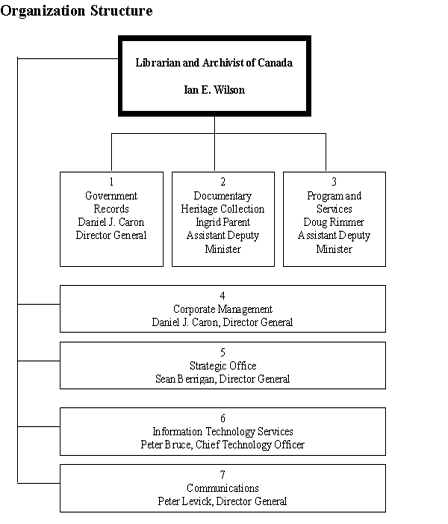
1, 2 and 3 are the operational sectors of Library and Archives Canada. They reflect our legislated mandate and program activity architecture. Corresponding strategic outcomes are:
- Information and knowledge are effectively managed within the Government of Canada.
- Canada's documentary heritage is safeguarded and organized for current and future generations.
- Canada's documentary heritage is known, accessible and used.
4, 5, 6 and 7 are enabling functions to foster corporate coordination and ensure that we work across the organizational structure.
Departmental Links to Government of Canada Outcome Areas
As noted in Section 1, all Library and Archives Canada activities take place in support of one strategic outcome, which supports the Government of Canada outcome of "A Vibrant Canadian Culture and Heritage."
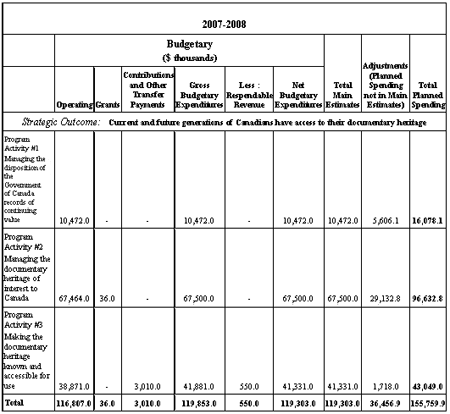
Planned Spending Trends
Planned spending decreases over the three year planning period due to sunsetting capital project initiatives including the construction of an Interim Collections Facility in Gatineau, Quebec and a cellulose nitrate-based Documentary Heritage Vault. Overall, salary related expenditures account for approximately 64% of planned spending, other operating and capital account for 33% of planned spending and transfer payments account for 3% of planned spending.
Financial Information
Table 1: Library and Archives Canada Planned Spending and Full Time Equivalents
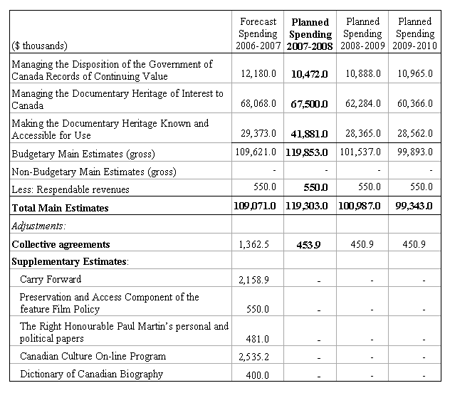
Table 1: Library and Archives Canada Planned Spending and Full Time Equivalents (cont'd)
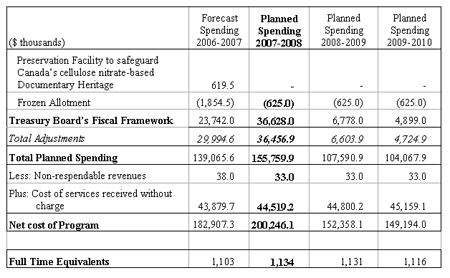
Table 2: Voted and Statutory Items listed in Main Estimates

Table 3: Library and Archives Canada Services Received without Charge
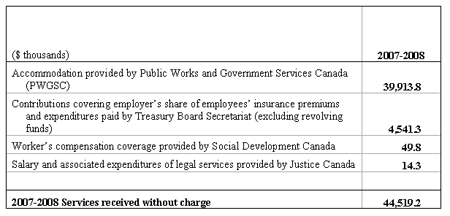
Table 4: Sources of Respendable and Non-Respendable Revenues


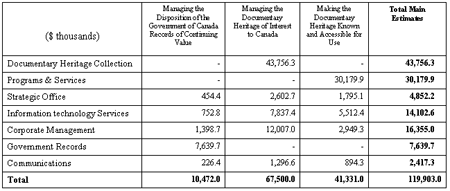
Legislation Administered by the Librarian and Archivist of Canada
The Librarian and Archivist of Canada has sole responsibility for the Library and Archives of Canada Act, Statutes of Canada, 2004, c.11. He shares responsibility for the Access to Information Act, R.S.C., 1985, c. A-1, and the Privacy Act, R.S.C., 1985, c. P-21.
Contacts for Further Information:
Library and Archives Canada
550 Place de la Cité Boulevard
Gatineau, Québec
K1A 0N4
General Information: (613) 996-5115
Toll free number in Canada and the U.S.: 1-866-578-7777
TTY: (613) 992-6969 or 1-866-299-1699 (toll free in Canada)
This report can be found in electronic format at www.collectionscanada.ca
For more information about the contents of this document, contact:
Sean Berrigan, Director General
Strategic Office
Tel: (819) 934-5858
Fax: (819) 934-5839
E-mail: sean.berrigan@lac-bac.gc.ca
1."Directions for Change" is available at www.lac-bac.gc.ca/about-us/016/index-e.html